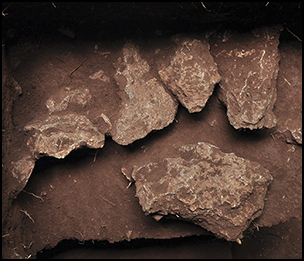Crossref Citations
This article has been cited by the following publications. This list is generated based on data provided by
Crossref.
Deng, Zhenhua
Hung, Hsiao-chun
Li, Zhen
Carson, Mike T.
Huang, Qiang
Huang, Yunzhong
and
Lu, Houyuan
2019.
Food and ritual resources in hunter-gatherer societies: Canarium nuts in southern China and beyond.
Antiquity,
Vol. 93,
Issue. 372,
p.
1460.
Ono, Rintaro
Pawlik, Alfred
and
Fuentes, Riczar
2020.
Pleistocene Archaeology - Migration, Technology, and Adaptation.
Lagan, Emma M.
and
Ehrlich, Daniel E.
2021.
An improved method for measuring molar wear.
American Journal of Physical Anthropology,
Vol. 174,
Issue. 4,
p.
832.
Samper Carro, Sofia C.
Stewart, Tahlia J.
Mahirta
Wood, Rachel
and
O'Connor, Sue
2021.
Burial practices in the early mid-Holocene of the Wallacean Islands: A sub-adult burial from Gua Makpan, Alor Island, Indonesia.
Quaternary International,
Vol. 603,
Issue. ,
p.
125.
Pawlik, Alfred F.
2021.
Technology, adaptation, and mobility in maritime environments in the Philippines from the Late Pleistocene to Early/Mid-Holocene.
Quaternary International,
Vol. 596,
Issue. ,
p.
109.
Carlhoff, Selina
Duli, Akin
Nägele, Kathrin
Nur, Muhammad
Skov, Laurits
Sumantri, Iwan
Oktaviana, Adhi Agus
Hakim, Budianto
Burhan, Basran
Syahdar, Fardi Ali
McGahan, David P.
Bulbeck, David
Perston, Yinika L.
Newman, Kim
Saiful, Andi Muhammad
Ririmasse, Marlon
Chia, Stephen
Hasanuddin
Pulubuhu, Dwia Aries Tina
Suryatman
Supriadi
Jeong, Choongwon
Peter, Benjamin M.
Prüfer, Kay
Powell, Adam
Krause, Johannes
Posth, Cosimo
and
Brumm, Adam
2021.
Genome of a middle Holocene hunter-gatherer from Wallacea.
Nature,
Vol. 596,
Issue. 7873,
p.
543.
Maloney, Tim Ryan
Dilkes-Hall, India Ella
Setiawan, Pindi
Oktaviana, Adhi Agus
Geria, I. Made
Effendy, Muslimin
Ririmasse, Marlon
Febryanto
Sriputri, Etha
Priyatno, Andika
Atmoko, Falentinus Triwijaya
Moffat, Ian
Brumm, Adam
and
Aubert, Maxime
2022.
A late Pleistocene to Holocene archaeological record from East Kalimantan, Borneo.
Quaternary Science Reviews,
Vol. 277,
Issue. ,
p.
107313.
Pawlik, Alfred F.
and
Fuentes, Riczar B.
2023.
Prehistoric Hunter-Gatherers in the Philippines—Subsistence strategies, adaptation, and behaviour in maritime environments.
Frontiers in Earth Science,
Vol. 11,
Issue. ,
Boulanger, Clara
Pawlik, Alfred
O’Connor, Sue
Sémah, Anne-Marie
Reyes, Marian C.
and
Ingicco, Thomas
2023.
The Exploitation of Toxic Fish from the Terminal Pleistocene in Maritime Southeast Asia: A Case Study from the Mindoro Archaeological Sites, Philippines.
Animals,
Vol. 13,
Issue. 13,
p.
2113.
Boulanger, Clara
Ingicco, Thomas
Sémah, Anne-Marie
Hawkins, Stuart
Ono, Rintaro
Reyes, Marian C.
and
Pawlik, Alfred
2023.
30,000 years of fishing in the Philippines: New ichthyoarchaeological investigations in Occidental Mindoro.
Journal of Archaeological Science: Reports,
Vol. 52,
Issue. ,
p.
104222.
C. Samper Carro, Sofia
2024.
The Prehistory of Human Migration - Human Expansion, Resource Use, and Mortuary Practice in Maritime Asia.
Hawkins, Stuart
Zetika, Gabriella Ayang
Kinaston, Rebecca
Firmando, Yulio Ray
Sari, Devi Mustika
Suniarti, Yuni
Lucas, Mary
Roberts, Patrick
Reepmeyer, Christian
Maloney, Tim
Kealy, Shimona
Stirling, Claudine
Reid, Malcolm
Barr, David
Kleffmann, Torsten
Kumar, Abhishek
Yuwono, Pratiwi
Litster, Mirani
Husni, Muhammad
Ririmasse, Marlon
Mahirta
Mujabuddawat, Muhammad
Harriyadi
and
O’Connor, Sue
2024.
Earliest known funerary rites in Wallacea after the last glacial maximum.
Scientific Reports,
Vol. 14,
Issue. 1,
Katagiri, Chiaki
2024.
The Prehistory of Human Migration - Human Expansion, Resource Use, and Mortuary Practice in Maritime Asia.
Hasanuddin
Suryatman
Supriadi
Saiful, A.M.
Lebe, Rustan
AKW, Bernadeta
D., Nur Ihsan
and
Sumantri, Iwan
2024.
Middle holocene burial and cultural dynamics at the liang sumpang Karoro 1 site, Maros, Indonesia.
Archaeological Research in Asia,
Vol. 40,
Issue. ,
p.
100565.
Pawlik, Alfred F.
Fuentes, Riczar B.
Faylona, Marie Grace Pamela G.
Palconit, Trishia Gayle R.
and
Uldin, Tanya
2025.
Chronology and ecology of early islanders in the Philippines: The Mindoro Archaeology Project.
Archaeological Research in Asia,
Vol. 42,
Issue. ,
p.
100616.
Changkiri, Taliyanger
2025.
Exploring mortuary beliefs and traditions: The burial practices of Nagas in highland Northeast India.
Anthropology and Humanism,
